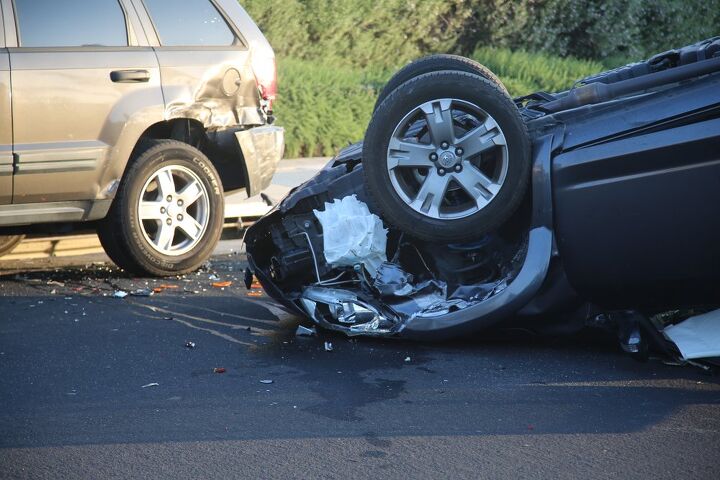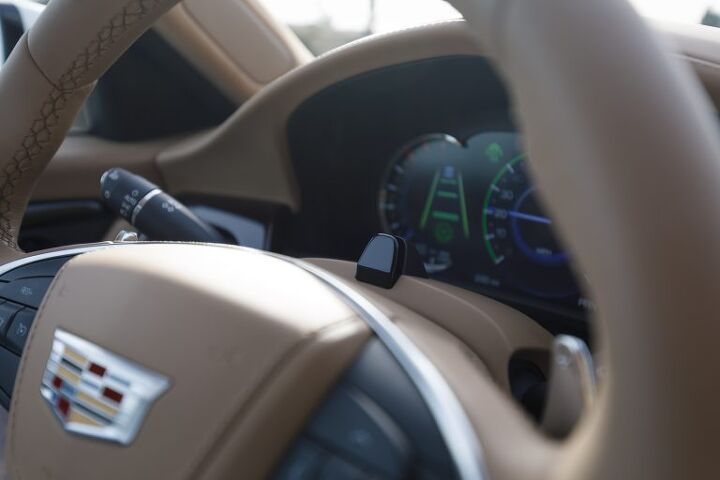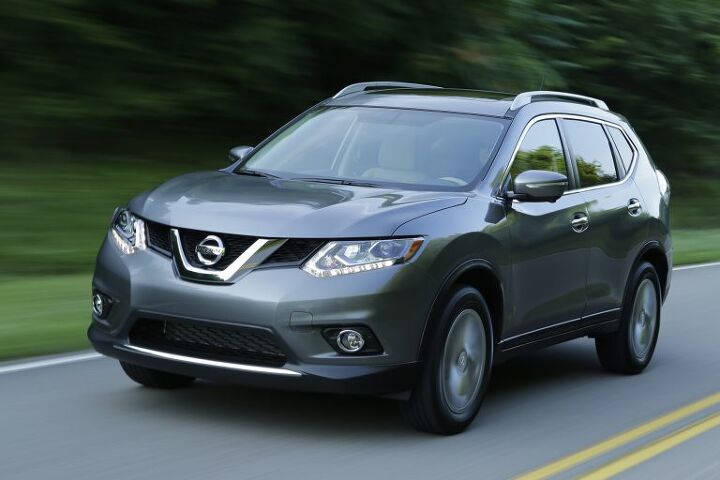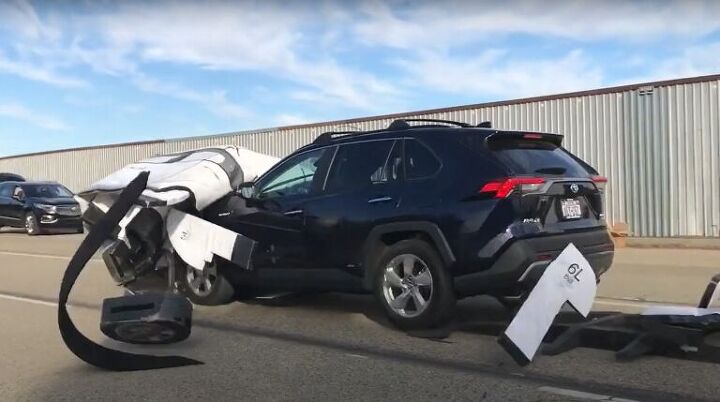#AutomotiveSafety
Kinda Sorta: Sweden Develops 'First' Female Crash Test Dummy
A team of engineers from Sweden has allegedly developed the first female crash test dummy. But what actually goes into making a human analog for crash testing and why haven’t there been more feminine versions of dummies that have technically existed for over 70 years?
Maybe we should start with a brief history lesson.
NHTSA Issues Initial Crash Report for Driver Assist Tech
In 2021, the National Highway Traffic Safety Administration (NHTSA) asked manufacturers to begin reporting vehicle accidents where Advanced Driver Assistance Systems (ADAS) and/or semi-autonomous driving aids were engaged. The agency was specifically interested in incidents where such systems were active at least 30 seconds prior to the crash, hoping it might shed some light as to the technologies at play while the industry continues to make it standard equipment.
Ford Recalling 'Mustang' Mach-E Over Battery Issues
On Monday, Ford Motor Co. notified dealers that it would be issuing a stop-sale notice for the all-electric “Mustang” Mach-E. The note made mention that the high-voltage contacts on the battery could overheat and cause malfunctions — potentially causing the vehicle to lose power while in operation or even fail to start.
Considering how absolutely wicked battery fires can become, this was likely a prudent move on the part of Ford. Over the last several years, EVs have been getting some negative attention for fires related to charging or battery failures of late and Blue Oval is likely aware that any mishaps with the Mach-E will be amplified as a result. Nipping this in the bud immediately is wise. However, the resulting recall has defaulted to the industry standard solution of issuing a software update on the affected models.
U.S. Congress Holds Hearing on Increased Traffic Deaths
A U.S. House of Representatives subcommittee conducted a hearing to discuss surging traffic deaths on Wednesday. In 2021, traffic deaths surged by over 10 percent over the previous year for a grand total of 42,915 roadway fatalities. But 2020 also represented a sizable 7 percent increase over 2019, despite there being overwhelming evidence that substantially less driving was done during nationwide COVID lockdowns.
Congresswoman Eleanor Holmes Norton (D-D.C.), the Transportation and Infrastructure subcommittee chair holding the hearing, stated that now was the time to hold a meeting on the issue — as last year represented the single highest increase in traffic deaths since the NHTSA started keeping track in 1975.
Goodyear Recalls Tire Nobody Uses Anymore
Goodyear has agreed to recall more than 173,000 intended for commercial delivery vehicles and RVs nearly two decades after the last one was manufactured. The company’s G159 tires have been under investigation by the National Highway Traffic Safety Administration (NHTSA) since December of 2017 and the recall comes in the wake of years of lawsuits alleging the rubber contributed to a series of fatal accidents dating back to 1998.
Despite no new claims having launched in years, court orders and settlement agreements delayed an order to make corporate data pertaining to the tire-buying public for five full years. The NHTSA didn’t even launch a formal investigation until late in 2017, followed by the recent announcement that the agency has pushed Goodyear into a recall for a tire that ended production during the Bush administration.
Why Are Traffic Deaths Increasing While People Are Driving Less?
The latest data from the National Highway Traffic Safety Administration (NHTSA) is confirming what local agencies have already been suggesting. Last year represented another sizable increase in U.S. roadway fatalities, pitching up by 10.5 percent over the elevated death rate witnessed in 2020. The agency has estimated that 42,915 people were killed in 2021, whereas 2020 resulted in 38,824 fatalities — a 7.1-percent increase over the declines seen in 2019. While the current situation is not nearly as bad as the rates witnessed during the 1970s, this still represents the highest per capita fatalities in sixteen years and everyone is trying to get a handle on why.
Traffic deaths have been on the rise since the start of the pandemic, confusing everyone who counts crashes because the supporting data also shows that there was a lot less driving being done during the period. Historically, years where people are disinclined from hitting the road due to a beleaguered economy tend to represent far fewer traffic-related fatalities. We can see this happening in 1942 when the U.S. braced itself to enter World War II by rationing everything from fuel to rubber. Another glaring example takes place in 1932, as the nation reached the darkest point in the Great Depression. In fact, there are very few examples of per capita improvements in on-road deaths from the pre-war period, and those that do exist coincide directly with economic recession.
Annoy the Driver: IIHS Says Seatbelt Chimes Aren't Loud Enough
The Insurance Institute for Highway Safety (IIHS) has spent the last few years branching out from crash tests to focus on some of the safety tech in modern vehicles. However, this arguably peaked when the group realized that modern vehicles with higher ride heights were blinding everyone with their headlights and decided that might be something worth including in general safety testing. The IIHS has since preoccupied itself with advocating for additional electronic nannies and mimicking government regulators by suggesting vehicles should annoy drivers as often as possible.
This week, that manifested by way of the IIHS upgrading its safety program to include pressuring manufacturers into making seat belt reminders more irritating. While the federal standards specify that undone belts must include an audible signal that lasts between four and eight seconds, in conjunction with a minute-long warning light, the non-profit (supported by insurance companies) believes reminders should be longer and louder than outlined by existing requirements.
AAA Endorses Driver-Monitoring Camera Systems
Despite the automotive industry collectively promising to commence deliveries of self-driving cars in 2019, autonomous vehicles have remained test platforms for technologies that don’t yet seem ready for mass consumption. Public perception of the concept has also endured a few setbacks after several fatalities involving partially autonomous vehicles received national media attention. Today, the relevant technologies have failed to mature as swiftly as indicated and there are a whole host of legal ramifications to contend with.
Selling an automobile that’s marketed as being able to drive itself (even partially) are exposing automakers to a whole new demographic of lawsuits, so they’re desperate to install failsafe measures that places the onus of responsibility back onto the driver. Their current favorite is driver-monitoring cameras, which the American Automobile Association (AAA) likewise believes are probably the best solution. The outlet recently shared the results of a study attempting to determine which driver-engagement systems worked best and decided that in-cabin cameras were the leading choice in a batch of bad options.
Nissan Recalling 793,000 Rogue SUVs Over Fire Risk
While alchemy has famously spent the better part of recorded history trying to transmute lead into gold, the automotive industry has repeatedly managed to achieve the lesser-known act of sorcery where water is converted into fire. This usually occurs when humidity ends up corroding an essential electrical component, resulting in fire risk that becomes the deciding factor in a recall campaign.
This week’s corporate conjurer is Nissan, which has decided to call back 793,000 Rogue SUVs in the United States and Canada.
Are Electric or Combustion Cars Better at Weathering a Winter Storm?
Following the Virginia shutdown of Interstate 95 that left countless people stranded in freezing weather overnight earlier this month, there was a surprising amount of news coverage making offhand comments about how victims would have been better off if they all were driving electric vehicles (Ed. note — there was also this Washington Post op-ed in which the author worried that an EV would be a poor vehicle to be stranded in And this Vice rebuttal to that article). While it seemed an inopportune time to advertise for EVs, it’s an interesting premise and encouraged Car and Driver to conduct a head-to-head experiment between a Tesla Model 3 and Hyundai Sonata N-Line to see who could keep the cabin warm for the longest period of time when stranded.
Realistically, you’d be better off in whatever vehicle is yielding the heaviest fuel tank or least-depleted battery when traffic stops. But there are other factors to consider. Idling an internal-combustion car for extended periods of time is not recommended and doing so when totally snowed in could potentially trap harmful exhaust gasses if the exhaust is not kept clear. Meanwhile, EVs are notorious for having their battery chemistry altered by colder temperatures. This is especially true if they lack the relevant thermal management systems, resulting in the maximum range being diminished by as much as 30 percent.
IIHS Takes a Dump on Semi-Autonomous Cars, Then Impositions Drivers
The Insurance Institute for Highway Safety (IIHS) has said it is developing a new rating system to evaluate the existing safeguards found inside vehicles equipped with partial automation. Considering how commonplace advanced driving aids have become, you might be thinking this was long overdue. However, insurers were blindly praising advanced driving suites a few years ago — until they actually started testing them in earnest.
As luck would have it, there’s been mounting research supporting claims modern automotive tech encourages drivers to tune out and become distracted. While this wouldn’t be a big deal if the relevant features all functioned perfectly, the reality is that most are far less effective than advertised and practically all of them run the risk of being completely undone by inclement weather or poor lighting. Confusingly, the IIHS believes the best solution here is to make sure systems constantly monitor the driver to ensure the driver is constantly monitoring the system.
Tesla Recalling 475,000 Cars Over Camera, Hood Latch Issues
The National Highway Traffic Safety Administration (NHTSA) has confirmed that Tesla will be recalling 356,309 examples of the Model 3 presumed to be suffering from a defect that can cause the rearview camera to malfunction. Another 119,009 Model S sedans will also be recalled over a problem pertaining to the frontal hood latch.
U.S. Regulators 'Crack Down' on Tesla for Letting Customers Play Video Games
The National Highway Traffic Safety Administration (NHTSA) has launched a formal investigation into 580,000 Tesla vehicles sold since 2017 that allowed customers to play video games inside the vehicle. The company has allowed users to play a variety of games while vehicles are in park, some of which allowed drivers to use the steering wheels and pedals as part of the controls, for quite some time. But an over-the-air software update permitted a few of them to be launched while the car was in motion by the passenger in the summer of 2021. Called “Passenger Play,” the service was limited to games that only used touchscreen controls.
It’s since been axed, however, regulators have taken an interest following some manufactured outrage. The NHTSA has faulted the feature as part of the ongoing distracted-driving problem in an attempt to link it to its crusade against Autopilot. The agency has launched a preliminary investigation into 580,000 Tesla Model 3, S, X, and Y vehicles to determine if they’re attention-sucking deathtraps.
Auto Theft Becomes Fashionable Again, Most Stolen Vehicles of 2020
Car theft has been trending downward over the last couple of years. According to data from the Insurance Information Institute, 2019 represented a 4-percent decline in thefts across the United States vs the previous annum. But things look even better when you zoom out. The Federal Bureau of Investigation estimates that automotive transgressions have fallen by 64 percent since 1993, mimicking the general trajectory of property and violent crimes within that timeframe.
Unfortunately, crime is back on the rise and vehicle theft is coming along for the ride. Let’s explore the how and why before determining if your personal ride happens to be a preferred target. Then we’ll get into what you can do about it because the latest statistics are pretty disheartening.
Rain or Shine: AAA Finds Out Advanced Driving Aids Still Suck
A new study from the American Automobile Association (AAA) has found that rain can severely impair advanced driver-assistance systems (ADAS). Similar to how highway traffic slows to a crawl when there’s a sudden deluge, modern safety equipment can have real trouble performing when a drizzle becomes a downpour.
On Thursday, the motor club organization released findings from closed-course testing that appeared to indicate some assistance suites had real trouble seeing through bad weather. AAA reported that 33 percent of test vehicles equipped with automatic emergency braking traveling collided with a stopped car when exposed to simulated rainfall at 35 mph. The numbers for automatic lane-keeping was worse, with 69 percent drifting outside the lines. Considering the number of times the people writing for this website have anecdotally criticized ADAS for misbehaving in snow, sleet, rain, fog, or just from an automobile being a little too dirty, it’s hard not to feel a little vindicated.





























Recent Comments